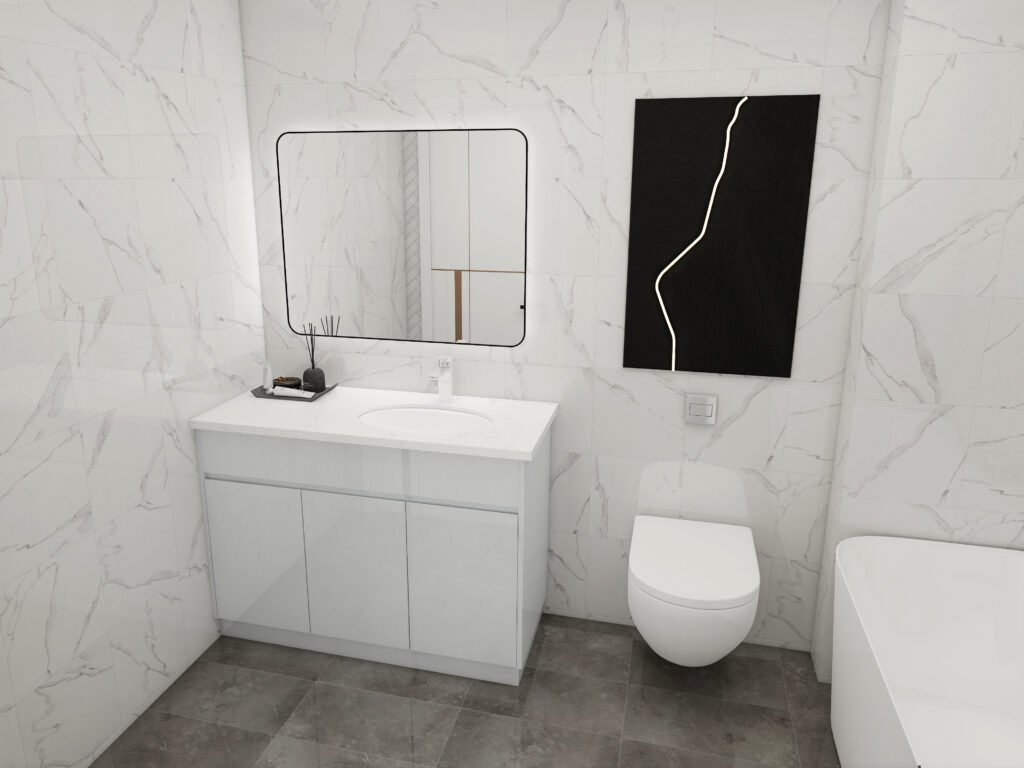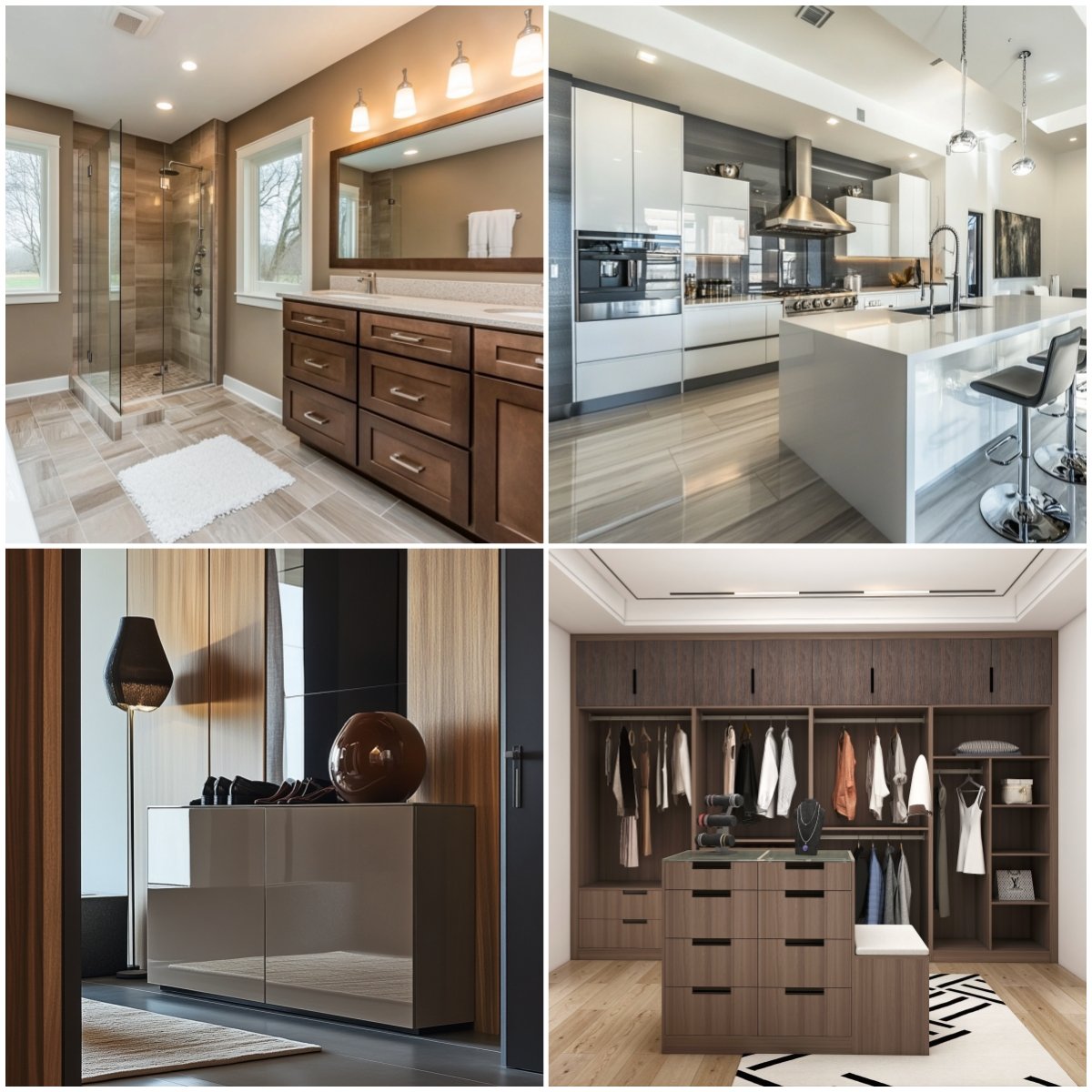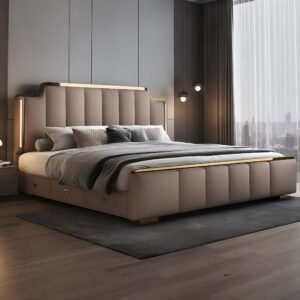When designing or renovating a bathroom, choosing between a vanity and a cabinet can be a key decision that impacts both functionality and aesthetics. While the terms “vanity” and “cabinet” are often used interchangeably, they refer to distinct types of furniture with unique features and purposes. Today, Cs Home will distinguish the difference between vanities and cabinets, their various types, and guide you on how to choose the right vanities and cabinets for your bathroom.
Definitions and Basic Differences
Vanity: A vanity is a piece of furniture that combines a sink with storage space. Typically found in bathrooms, vanities serve both functional and aesthetic purposes. They usually include a countertop, sink, and storage cabinets or drawers underneath. Vanities are designed to provide a convenient place for personal grooming and hygiene activities, such as washing hands, brushing teeth, and applying makeup.

Cabinet: A cabinet is a more general term that refers to a piece of furniture with doors and shelves used for storing items. Cabinets can be found in various rooms throughout the house, including kitchens, bathrooms, bedrooms, and living rooms. They come in many shapes and sizes and can be used to store anything from dishes and cookware to clothing and toiletries.

Functional Differences
The primary functional difference between a vanity and a cabinet lies in their intended use. Vanities are specifically designed for bathrooms and are equipped with plumbing to accommodate a sink. This makes them ideal for personal grooming and hygiene tasks. Cabinets, however, are more versatile and can be used in any room for general storage purposes. They do not typically include plumbing or a sink.
Types of Vanities
- Single Vanity: Ideal for smaller bathrooms, single vanities provide sufficient storage space while occupying minimal floor space. They typically feature one sink and a countertop, with drawers or shelves underneath for toiletries and other essentials.
- Double Vanity: Perfect for larger bathrooms, double vanities offer two sinks and more extensive storage space. This type of cabinet is great for shared bathrooms, as it provides ample room for two people to use the space simultaneously.
- Floating Vanity: These cabinets are mounted to the wall, creating a floating effect. Floating vanities are a modern and sleek option that can make a small bathroom feel more spacious. They also make cleaning the floor easier, as there are no legs or base touching the ground.
Types of Cabinets
- Medicine Cabinets: Typically installed above the sink or toilet, medicine cabinets are small wall-mounted units designed to store medications, first-aid supplies, and other small items. They often feature a mirrored front, adding functionality as both a mirror and storage solution.
- Wall Cabinets: Larger and more versatile than medicine cabinets, wall cabinets are mounted on the wall and can be used to store a variety of bathroom items, from toiletries to cleaning supplies. They come in open shelving styles for easy access or closed designs for a cleaner appearance.
- Corner Cabinets: Designed to fit into the corner of a bathroom, corner cabinets make efficient use of often underutilized space. They come in various styles and sizes, offering a practical storage solution for smaller bathrooms.
- Over-the-Toilet Cabinets: These cabinets are designed to maximize vertical space by utilizing the area above the toilet. They can be freestanding or wall-mounted, providing shelves or cabinets for storing toiletries, towels, and other items.
- Custom Cabinets: Custom cabinets are tailored to fit the specific needs and dimensions of your bathroom. They offer the highest level of personalization and can be designed to match your exact preferences and style.
Aesthetic Differences
From an aesthetic standpoint, vanities and cabinets can vary significantly. Vanities often serve as a focal point in a bathroom, and their design can greatly influence the overall look and feel of the space. They come in a wide range of styles, from traditional to modern, and can be made from various materials, including wood, metal, and glass. The countertop material is also an important consideration, with options such as granite, marble, and quartz available.
Cabinets, while also available in many styles and materials, are generally more understated in their design. They are often chosen to complement the existing decor of a room rather than to stand out as a focal point. However, this does not mean that cabinets cannot be stylish. High-quality cabinets with intricate designs and finishes can add a touch of elegance to any room.
Materials and Construction
The materials used in the construction of vanities and cabinets can vary widely, but there are some common choices for each.
Vanities:
- Wood: Solid wood or engineered wood is a popular choice for vanity construction due to its durability and natural beauty. Common wood types include oak, maple, and cherry.
- Metal: Metal vanities, often made from stainless steel or aluminum, offer a sleek, modern look and are highly durable.
- Glass: Glass vanities, particularly those with glass countertops or sinks, provide a contemporary and elegant appearance.
Cabinets:
- Wood: Like vanities, cabinets are often made from solid wood or engineered wood. The choice of wood can affect the cabinet’s durability and appearance.
- Laminate: Laminate cabinets are a cost-effective option that offers a wide range of colors and patterns. They are easy to clean and maintain.
- Metal: Metal cabinets, often used in industrial or modern designs, are durable and can add a unique aesthetic to a room.
Installation and Maintenance
Vanities: Installing a vanity can be more complex than installing a cabinet due to the need for plumbing connections. It is often advisable to hire a professional plumber to ensure that the sink and faucet are properly installed and that there are no leaks. Maintenance of a vanity involves regular cleaning of the countertop, sink, and storage areas to prevent the buildup of dirt and grime.
Cabinets: Cabinet installation is generally simpler and can often be done as a DIY project. The main considerations are ensuring that the cabinet is level and securely attached to the wall or floor. Maintenance of cabinets involves regular dusting and cleaning of the surfaces and interior shelves.
Choosing Between a Vanity and a Cabinet
When deciding between a vanity and a cabinet, consider the following factors:
- Position: If you need a piece of bathroom furniture for your master bedroom, a vanity is the obvious choice because it has an integrated sink and plumbing. For other rooms, a cabinet may be more appropriate.
- Functionality: Consider what you need the furniture for. If you require a sink and a surface for personal grooming, a vanity is the best option. If you need general storage, a cabinet may be more suitable.
- Style: Both dressers and cabinets come in a variety of styles, choose a piece that complements the overall design of your space.
- Budget: Since vanities have integrated sinks and countertops, they can be more expensive than cabinets, but high-end custom cabinetry can also be pricey.
Conclusion
Understanding the differences between vanities and cabinets is crucial for making informed decisions during home renovations or when purchasing new furniture. Vanities are designed for bathrooms, providing a convenient place for personal grooming and hygiene activities with integrated sinks and storage. Cabinets, on the other hand, are versatile storage units that can be used in any room for a variety of purposes.
When choosing between a vanity and a cabinet, consider factors such as location, functionality, style, and budget. By taking these factors into account, you can select the right piece of furniture that meets your needs and enhances the overall design of your space. Whether you opt for a stylish vanity or a practical cabinet, both can significantly contribute to the functionality and aesthetics of your home.
FAQs
Q1. What is the main difference between a vanity and a regular cabinet?
A1:
A vanity typically includes a sink and storage space, mainly used in bathrooms; a regular cabinet is used in various rooms for storing items and does not include a sink.
Q2. What types of vanities are there?
A2:
Common types include single vanities, double vanities, and floating vanities.
Q3. What is the function of a medicine cabinet?
A3:
A medicine cabinet is used to store medications and first-aid supplies, often featuring a mirror.
Q4. What are the advantages of a corner cabinet?
A4:
Corner cabinets efficiently utilize bathroom corner space, making them suitable for small bathrooms.
Q5. What should be considered when choosing a bathroom cabinet?
A5:
Consider space, storage needs, style, material durability, and budget.




